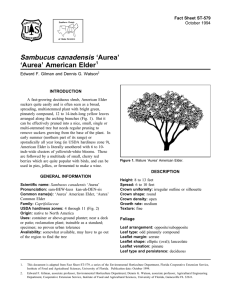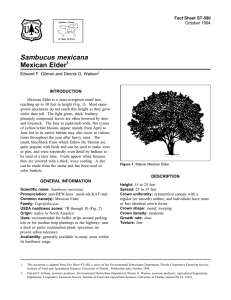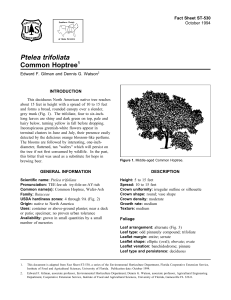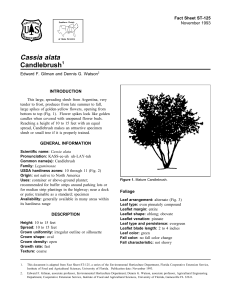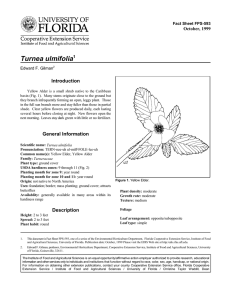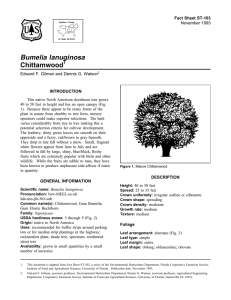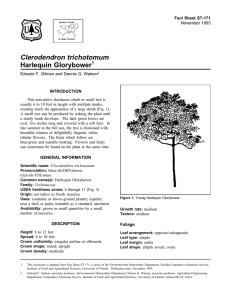Sambucus canadensis American Elder Fact Sheet ST-578 1
advertisement
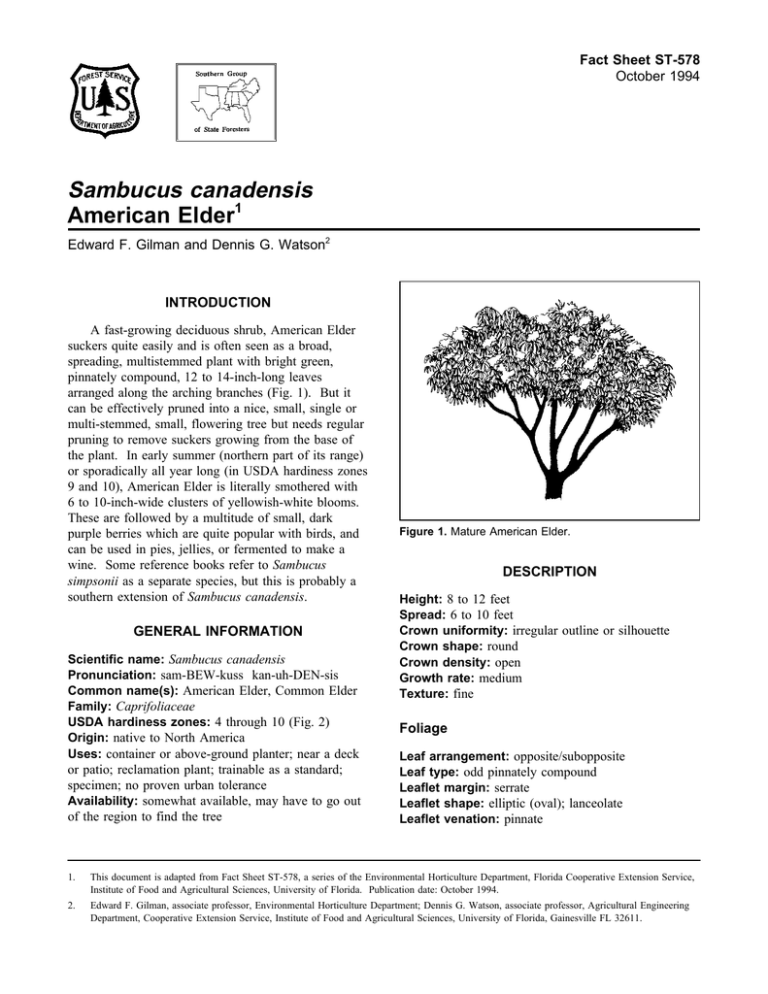
Fact Sheet ST-578 October 1994 Sambucus canadensis American Elder1 Edward F. Gilman and Dennis G. Watson2 INTRODUCTION A fast-growing deciduous shrub, American Elder suckers quite easily and is often seen as a broad, spreading, multistemmed plant with bright green, pinnately compound, 12 to 14-inch-long leaves arranged along the arching branches (Fig. 1). But it can be effectively pruned into a nice, small, single or multi-stemmed, small, flowering tree but needs regular pruning to remove suckers growing from the base of the plant. In early summer (northern part of its range) or sporadically all year long (in USDA hardiness zones 9 and 10), American Elder is literally smothered with 6 to 10-inch-wide clusters of yellowish-white blooms. These are followed by a multitude of small, dark purple berries which are quite popular with birds, and can be used in pies, jellies, or fermented to make a wine. Some reference books refer to Sambucus simpsonii as a separate species, but this is probably a southern extension of Sambucus canadensis. GENERAL INFORMATION Scientific name: Sambucus canadensis Pronunciation: sam-BEW-kuss kan-uh-DEN-sis Common name(s): American Elder, Common Elder Family: Caprifoliaceae USDA hardiness zones: 4 through 10 (Fig. 2) Origin: native to North America Uses: container or above-ground planter; near a deck or patio; reclamation plant; trainable as a standard; specimen; no proven urban tolerance Availability: somewhat available, may have to go out of the region to find the tree Figure 1. Mature American Elder. DESCRIPTION Height: 8 to 12 feet Spread: 6 to 10 feet Crown uniformity: irregular outline or silhouette Crown shape: round Crown density: open Growth rate: medium Texture: fine Foliage Leaf arrangement: opposite/subopposite Leaf type: odd pinnately compound Leaflet margin: serrate Leaflet shape: elliptic (oval); lanceolate Leaflet venation: pinnate 1. This document is adapted from Fact Sheet ST-578, a series of the Environmental Horticulture Department, Florida Cooperative Extension Service, Institute of Food and Agricultural Sciences, University of Florida. Publication date: October 1994. 2. Edward F. Gilman, associate professor, Environmental Horticulture Department; Dennis G. Watson, associate professor, Agricultural Engineering Department, Cooperative Extension Service, Institute of Food and Agricultural Sciences, University of Florida, Gainesville FL 32611. Sambucus canadensis -- American Elder Page 2 Figure 2. Shaded area represents potential planting range. Leaf type and persistence: deciduous Leaflet blade length: 4 to 8 inches; 2 to 4 inches Leaf color: green Fall color: yellow Fall characteristic: not showy Flower Flower color: white Flower characteristics: showy; summer flowering grown with, or trainable to be grown with, multiple trunks; not particularly showy; no thorns Pruning requirement: requires pruning to develop strong structure Breakage: susceptible to breakage either at the crotch due to poor collar formation, or the wood itself is weak and tends to break Current year twig color: gray Current year twig thickness: thick Culture Fruit Fruit Fruit Fruit Fruit Fruit shape: round length: < .5 inch covering: fleshy color: black; purple characteristics: attracts birds; suited for human Light requirement: tree grows in full sun Soil tolerances: clay; loam; sand; acidic; alkaline; extended flooding; well-drained Drought tolerance: moderate Aerosol salt tolerance: low Soil salt tolerance: poor consumption; no significant litter problem; showy Other Trunk and Branches Trunk/bark/branches: bark is thin and easily damaged from mechanical impact; droop as the tree grows, and will require pruning for vehicular or pedestrian clearance beneath the canopy; routinely Roots: surface roots are usually not a problem Winter interest: no special winter interest Outstanding tree: not particularly outstanding Invasive potential: seeds itself into the landscape Ozone sensitivity: sensitive or moderately tolerant Sambucus canadensis -- American Elder Verticillium wilt susceptibility: susceptible Pest resistance: long-term health usually not affected by pests USE AND MANAGEMENT Ideal for use in naturalized landscapes where it will tolerate acid or alkaline soil and even some drought, American Elder performs best in full sun on moist to wet, fertile soils. Plant it in the shrub border or locate it next to the patio for a wonderful flower display. The plant is often overlooked by the trade perhaps because it is so commonly found in and along the woods, but it has a place in the garden, although its rather random habit may not make it popular in the commercial landscape. Requires pruning to create a neat small tree. A few cultivars include: ‘Acutiloba’, leaflets very deeply divided, a nice fine-textured plant; ‘Aurea’, bright red fruit, yellow leaves; ‘Adams’, fruits in dense, large clusters, excellent for baking. There are a variety of other very attractive species. Propagation is by seed or cuttings. Pests Borers, occasional leaf-chewing insects, may infest this tree. Diseases American Elder can be infected by cankers, leaf spots, powdery mildew. Page 3
